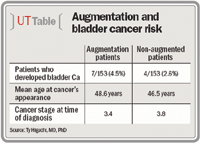Article
Augmentation cystoplasty may not raise bladder cancer risk after all
A new study challenges what many urologists may feel is understood-that augmentation serves as an independent risk factor for malignancy in young patients with inherent congenital bladder anomalies.
Washington-A recent study by Mayo Clinic, Rochester, MN researchers calls into question the widely believed association between augmentation cystoplasty and bladder cancer.
"Augmentation does not appear to be an independent risk factor for the development of bladder cancer," first author Ty Higuchi, MD, PhD, a Mayo Clinic urology resident working with Douglas A. Husmann, MD, and colleagues, told Urology Times.

"We know that patients undergoing cystoplasty are at risk for a number of problems such as recurrent infections and metabolic abnormalities. The question has been raised as to whether these patients have an increased risk of bladder cancer," Dr. Higuchi said.
The first papers to raise that question appeared in the late 1980s and early 1990s. Most of the literature on the subject consists of case reports and studies involving small series. Despite this scanty literature, many urologists accepted the proposition as fact; a number of studies begin by stating that patients who have had surgical bladder augmentation have an increased risk of bladder malignancy.
Data supporting link 'limited'
Dr. Higuchi and colleagues, in presenting their study, repeat this statement but add, "The data supporting this statement is limited, and to date there have been no studies comparing the risk of developing bladder cancer in congenital bladder abnormalities managed with or without augmentation cystoplasty."
To explore the relationship between anomalies, augmentation, and cancer, the Mayo Clinic team reviewed the registry of children compiled by senior author Dr. Husmann. The children had presented with bladder anomalies due to neurologic anomaly, exstrophy/epispadias, and posterior urethral valves. They identified 153 patients who had undergone ileal or colonic augmentation and were able to match them 1 to 1 in terms of etiology of bladder dysfunction, gender, and age (+/–2 years) with controls who had not undergone the procedure. The controls with bladder anomalies were managed with intermittent catheterization. Importantly, the authors point out that their study did not include patients with gastrocystoplasty.
The average follow-up interval after augmentation was 27 years, and the average age at the time the study was conducted was 41 years.
Some 4.5% (7/153) of those patients undergoing augmentation developed bladder cancer, compared to 2.6% (4/153) in non-augmented patients. The cancer appeared in augmented patients at a mean age of 48.6 years compared to 46.5 years in non-augmented patients. The stage of the cancer at the time of diagnosis was 3.4 in the augmented group versus 3.8 in the non-augmented group. There was no significant increased risk of cancer arising in the augmented patients when compared to the etiology, gender, and age of matched controls.
Dr. Higuchi recognizes that the cancer rates among these patients were higher than those seen in the general population.
"When you look at cancer rates in the general population, SEER [Surveillance, Epidemiology, and End Results] puts it around 2% and the median age at diagnosis at about 73. Our overall cancer rate in the study cohort was higher at 3.6% at a median age of 51," Dr. Higuchi said.
These data suggest that the cancers appearing in patients with congenital anomalies are more aggressive and appear at an earlier age than the normal population, irrespective of bladder augmentation.
The study is not conclusive, said Dr. Higuchi. A multicenter study is needed to resolve the issue, he said, noting that some of the team's findings may have been affected by the institution's status as a tertiary hospital, whose patients may differ from those seen in general practice.




